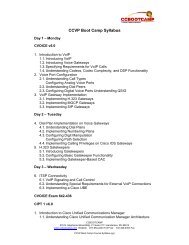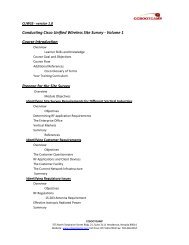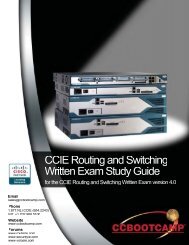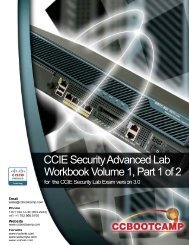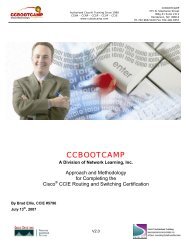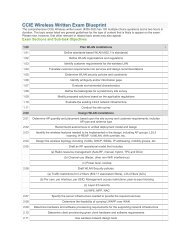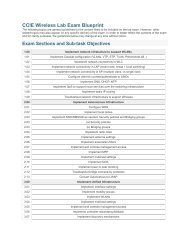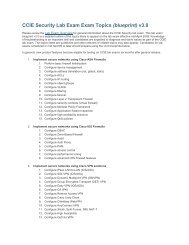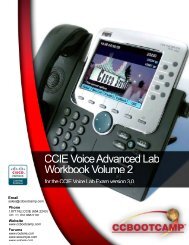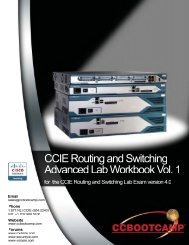CCDE Written Exam
CCDE 352-001.pdf
CCDE 352-001.pdf
- No tags were found...
You also want an ePaper? Increase the reach of your titles
YUMPU automatically turns print PDFs into web optimized ePapers that Google loves.
<strong>CCDE</strong> <strong>Written</strong> <strong>Exam</strong>BlueprintThe following blueprint provides general guidelines for the content to be included on the<strong>CCDE</strong> <strong>Written</strong> exam (#352-001). Please note, however, that other relevant or relatedtopic areas may also appear.1 IP Routing1.1 Explain route aggregation concepts and techniques1.1.1 Purpose of route aggregationa. Scalabilityb. Fault isolation1.1.2 How to aggregate1.2 Explain the theory and application of network topology abstraction and layering1.2.1 Layers and their purposea. Core, aggregation, distribution, access1.2.2 Purpose of Link State Topology Summarizationa. What is the purpose of Link State topology summarization (not how itworks)1.2.3 Use of Link State Topology Summarizationa. Where and how to build a flooding domain border1.3 Explain the impact of fault isolation and resiliency on network design1.3.1 What is the impact of fault isolation on network reliabilitya. Separating rapid and/or massive changes from the remainder of thenetwork, how to create fault isolation1.3.2 What is fate sharing, and what is its impact1.3.3 What is the impact of redundancy on convergence times1.4 Explain metric based traffic flow and modification1.4.1 How to engineer metrics to modify traffic flowa. MPLS versus IGP Traffic Engineeringb. Modifying IGP Metrics to Engineer Traffic Flow1.4.2 Understanding Traffic Flow & Metrics1.4.3 Third Party Next Hopa. Impact on redistribution design1.5 Explain fast convergence techniques and mechanisms1.5.1 Layer 2 Down Detectiona. For all media types1.5.2 Fast hello timersa. OSPF, EIGRP, IS-IS, BGP1.5.3 Fast SPF Timersa. OSPF, IS-IS<strong>CCDE</strong> <strong>Written</strong> <strong>Exam</strong> Blueprint Page 1 of 10 Cisco Systems, Inc. © 2011
1.5.4 Recursion and Convergencea. Impact of Third Party Next Hop & BGP recursion1.6 Explain routing protocol operation1.6.1 Neighbor Relationshipsa. OSPF, EIGRP, IS-IS, BGP1.6.2 Determining Loop Free Pathsa. OSPF, EIGRP, IS-IS, BGP, MPLS Constrained SPF1.6.3 General Operationa. OSPF, EIGRP, IS-IS, BGP; How each protocol operates1.6.4 Flooding Domains and Stubsa. OSPF/IS-IS flooding domains, EIGRP stubs1.6.5 iBGP Mesha. Next hop mechanisms in BGP, RR's, etc.1.7 Select lower operational costs and complexity1.7.1 Route Filtersa. Simple versus complex1.7.2 General1.7.3 Redistributiona. Simple designs, tags, route filters, etc.1.8 Explain transport mechanisms and interaction with routing protocols1.8.1 Link Characteristicsa. Point-to-point, point-to-multipoint, broadcast, etc.1.8.2 RP Implementation on Various Linksa. OSPF on each link typeb. IS-IS on each link typec. EIGRP considerations for point-to-multipoint1.8.3 Topology Characteristicsa. Full mesh, partial mesh, ring, etc.1.8.4 RP Implementation on Various Topologiesa. OSPF/IS-IS flood blocking, etc.1.9 Explain generic routing and addressing concepts1.9.1 Policy Based Routing1.9.2 IPv6 Basics1.10 Explain multicast routing concepts1.10.1 General Multicast concepts<strong>CCDE</strong> <strong>Written</strong> <strong>Exam</strong>Blueprint<strong>CCDE</strong> <strong>Written</strong> <strong>Exam</strong> Blueprint Page 2 of 10 Cisco Systems, Inc. © 2011
<strong>CCDE</strong> <strong>Written</strong> <strong>Exam</strong>Blueprint2 Tunneling2.1 Explain how tunneling affects end service applications2.1.1 Identify and select tunneling technologies appropriate to meet networkdesign objectives2.1.2 Identify where and when tunneling parameters must be tuned to optimize theoperation of end user applications2.1.3 Knowledge of issues related to Layer 2 tunneling: packet ordering, MTU, etc.2.1.4 What technologies support Layer 2 and Layer 3 tunneling: L2TPv3, GRE,ATOM, IPsec, etc.2.1.5 How to implement tunneling given a specific situation: tunneling Novel IPXover a Layer 3 service provider core, etc.2.1.6 Understanding of issues related to tunneling L3(IP) in L2(ATM, MPLS)2.2 Explain, recognize, and select tunneling techniques appropriate to the size andscale of the network requirements2.2.1 What is the impact of different tunneling technologies on scalability(Selection of a tunneling technology with scalability as a criteria)2.2.2 How scalability is affected based on type of tunnels (point-to-point, point-tomultipoint)2.3 Explain how L3 routing is affected by tunneling technologies and select L3 routingprotocols appropriate to implement tunneling and as passenger traffic in tunnels2.3.1 How L3 routing is overlaid on a given tunneling technologies2.3.2 What L3 Routing Protocol would suit a given tunneling technology, topologyand scalability2.4 Explain, recognize, and select logical and physical topologies required to meetnetwork design requirements2.4.1 What are the best points/nodes in network to initiate and terminate tunnels2.4.2 Which model would fulfill the requirements (full mesh, partial mesh,hierarchical)2.5 Explain, recognize, and select methods for interconnecting tunneling environmentsacross one or more service provider networks2.5.1 Describe different inter-provider tunneling models (2547, GRE, IPsec, etc.)2.6 Explain, recognize, and select methods for steering traffic with tunnels and intotunnels2.6.1 Class Based Tunnel Selection2.6.2 Traffic Engineering<strong>CCDE</strong> <strong>Written</strong> <strong>Exam</strong> Blueprint Page 3 of 10 Cisco Systems, Inc. © 2011
<strong>CCDE</strong> <strong>Written</strong> <strong>Exam</strong>Blueprint2.7 Explain, recognize, and select methods for providing network failover andredundancy to meet network availability requirements2.7.1 Restoration versus Protection (IGP Fast Convergence, FRR)2.7.2 Non-stop Forwarding versus Restoration (at the IP routing layer)2.8 Explain, recognize, and select methods for interconnecting different types ofattachment media on tunnel endpoints. Recognize and explain the differences inmapping different L2 technologies onto an L3 tunneling environment2.8.1 Interworking2.8.2 Mapping Layer 2 service onto Layer 3 at the edge2.9 Explain, recognize, and select methods to manage the size and scale of broadcastdomains in tunneled L2VPN environments2.9.1 VPLS scaling issues2.9.2 Spanning Tree issues2.9.3 Broadcast issues across various topologies<strong>CCDE</strong> <strong>Written</strong> <strong>Exam</strong> Blueprint Page 4 of 10 Cisco Systems, Inc. © 2011
<strong>CCDE</strong> <strong>Written</strong> <strong>Exam</strong>Blueprint3 QoS3.1 Measure and interpret different QoS performance metrics3.1.1 Correlate performance metrics to application performance3.1.2 Knowledge of the different QoS performance metrics: one-way delay, roundtripdelay, jitter, etc.3.1.3 How to measure and interpret QoS performance metrics3.1.4 How QoS performance metrics relate to user applications: impact of QoSmetrics on application performance, etc.3.2 Determine why, where and how to implement traffic classification, trafficconditioning and PHB3.2.1 Explain how DiffServ QoS tools work3.2.2 What DiffServ Terminology means (DS codepoint, Meter, DS ingress/egressnode, Remark, DS domain, etc.)3.2.3 Where to do Traffic Classification (edge and core of DS Domain)3.2.4 What is Traffic Conditioning and where is it applied? (metering, marking,shaping and policing)3.2.5 What are traffic profiles and meaning of in/out of profile (Token bucket)3.2.6 What is the difference between micro-flow and DS behavior aggregate(PHB)3.2.7 What is the impact on non-DS-compliant nodes within a DS domain on SLAs3.2.8 What is the issue with MF Classifier and Fragmentation3.2.9 What is the issue with re-marking and OoO packets3.2.10 What is the purpose of shapers and droppers3.2.11 What are different PHB models (x% minimal resources and proportionalremaining link capacity, etc.)3.2.12 What are issues with Different number/type of PHBs in different part of thenetwork3.2.13 What are the benefits of MF classification on edge and DS classification inthe core3.2.14 Understanding Classification/conditioning/PHB on a per customer basis orfew number of templates3.2.15 What are ways of DS Field Mapping to PHB: 1->1 or N->1 or both3.2.16 What are tools for PHB Queue management and bounding delay, jitter,packet loss (TS, WRED, WFQ, etc.)3.2.17 Understanding QoS provides differentiated services only when there iscontention for resources<strong>CCDE</strong> <strong>Written</strong> <strong>Exam</strong> Blueprint Page 5 of 10 Cisco Systems, Inc. © 2011
<strong>CCDE</strong> <strong>Written</strong> <strong>Exam</strong>Blueprint3.3 Explain operations of RSVP3.3.1 How RSVP Application does CAC and resource reservation3.4 Explain generic QoS requirements for common application (VoIP, Video, TCP, UDP,control plane traffic)3.4.1 Explain QoS requirements for control plane traffic3.4.2 What are generic VoIP Requirements3.4.3 What are generic Video Requirements3.4.4 What are generic TCP Requirements3.4.5 What are generic UDP Requirements3.4.6 Understanding of differentiation of control traffic versus data traffic3.4.7 Where and how to define marking/conditioning of Control Traffic3.5 Explain the techniques to avoid Class starvation when multiple classes are used(EF and non-EF)3.5.1 How EF with a policer and MDRR/Priority Queue solves the problem3.5.2 How minimum BW assignment per class or proportional BW assignmentamong all classes solves the problem3.5.3 What is the impact of applications' traffic within a given queue with same DSor different DS codepoint3.5.4 What is the impact of applications' traffic riding on the same node/link incase of failure3.6 Explain the interaction of IP DSCP with other marking schemes (IP Prec, .1P, MPLSEXP, ATM, Frame Relay)3.6.1 Interaction between DSCP and other technologies(understanding/issues/concerns)a. Ethernetb. ATMc. Frame Relayd. MPLSe. RPRf. IP Precf.1. In case of tunneling layers of marking: Differentiation betweentunnel marking and data packet marking<strong>CCDE</strong> <strong>Written</strong> <strong>Exam</strong> Blueprint Page 6 of 10 Cisco Systems, Inc. © 2011
<strong>CCDE</strong> <strong>Written</strong> <strong>Exam</strong>Blueprint3.7 Explain QoS based routing (PBR)3.7.1 Situations where one has to pick one or two of the following to solve aproblem (and understanding of the following)a. BGP QoS Propagationb. MTRc. OERd. PBRe. CBTS<strong>CCDE</strong> <strong>Written</strong> <strong>Exam</strong> Blueprint Page 7 of 10 Cisco Systems, Inc. © 2011
<strong>CCDE</strong> <strong>Written</strong> <strong>Exam</strong>Blueprint4 Management4.1 Analyze network conditions and behavior to determine potential degradation orfailure conditions4.1.1 Recognize conditions from SHOW output for data plane, control plane,hardware, etc.4.1.2 Recognize conditions from DEBUG output for data plane, control plane,hardware, etc.4.1.3 Recognize conditions from network behaviors for data plane, control plane,hardware, etc.4.1.4 Recognize conditions from external monitoring and reporting systems4.2 Explain the operation and advantages of different management access mechanisms4.2.1 How to implement out of band access to all devices in a network4.2.2 What should be considered when defining secure access to routers4.2.3 Recognize when and where a design will result in failure4.3 Explain the operation and use of network management protocols4.3.1 Differences between the versions of SNMP4.3.2 Knowledge of puts, gets, operations (read, write)4.3.3 Use of SNMP in SLA management4.3.4 Identify when use of CMIP is appropriate4.3.5 Identify when use of TMN is appropriate4.4 Identify network management tools and their uses4.4.1 Recognize tools used for SLA management4.4.2 Identify use of Generic On-Line Diagnostics (GOLD)4.4.3 Identify and Classify tools for Event Management4.4.4 State rules for use of Syslog4.4.5 Knowledge of where to place Netflow Collectors4.4.6 Identify Services required for flow collection4.4.7 Recognize Port number for Netflow4.4.8 Identify services required for event correlation4.5 Identify auditable factors in a network4.5.1 Identify auditable factors in a network4.6 Explain traffic management concepts and actions based on traffic statistics4.6.1 What is a traffic matrix4.6.2 When to upgrade a link or re-route traffic4.6.3 Interpretation of historical data to predict future growth and needs<strong>CCDE</strong> <strong>Written</strong> <strong>Exam</strong> Blueprint Page 8 of 10 Cisco Systems, Inc. © 2011
<strong>CCDE</strong> <strong>Written</strong> <strong>Exam</strong>Blueprint4.7 Recognize configuration management tools and best practices4.7.1 Recognize uses of templating tools4.7.2 Identify best practices for configuration management (logging configchanges, auditing "as running" versus "as configured," consistent featureapplication, etc.)4.7.3 Describe role-based configuration access<strong>CCDE</strong> <strong>Written</strong> <strong>Exam</strong> Blueprint Page 9 of 10 Cisco Systems, Inc. © 2011
<strong>CCDE</strong> <strong>Written</strong> <strong>Exam</strong>Blueprint5 Security5.1 Explain the impact of security availability design in the characteristics of a network5.1.1 OOB Access5.1.2 Decoupling5.1.3 Paul Baran Model5.1.4 Compartmentalization5.2 Use available tools in a network security design to address identity, monitoring andcorrelation aspects5.2.1 SNMP5.2.2 Netflow5.2.3 Syslog5.2.4 RMON5.2.5 DNS5.2.6 Radius/AAA5.2.7 Full Packet Classifiers5.3 Explain the impact of control plane design decisions on the security of a network;implement security mechanisms to protect the control plane5.3.1 Use and impact of addressing5.3.2 Use and impact of area (flooding domain/summary points) placement5.3.3 Route/Topology/Link Hiding5.3.4 Adjacency Protection (MD5, GTSM, etc.)5.3.5 Route Validation5.3.6 Route Filtering5.3.7 Routing Plan5.3.8 Other routing techniques5.4 Explain the impact of data plane design decisions on the security of a network;implement security mechanisms to protect the data plane5.4.1 Infrastructure Protection5.4.2 Policy Enforcement (QoS, BCP38)5.5 Prepare and explain security incident preparation and response strategies in anetwork5.5.1 Reaction Tools (Identification and Classification)5.5.2 Traceback Tools5.5.3 Remotely-Triggered Black Holes (RTBH) (destination, source, rate limit, etc.)5.5.4 Sink Holes5.5.5 Reactive ACLs<strong>CCDE</strong> <strong>Written</strong> <strong>Exam</strong> Blueprint Page 10 of 10 Cisco Systems, Inc. © 2011




